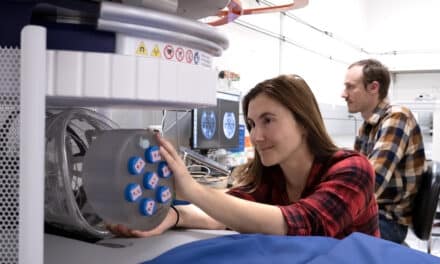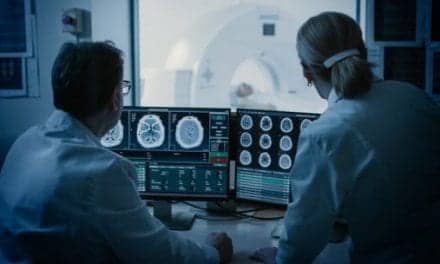 Edmond A. Knopp, MD, Vivian S. Lee, MD, PhD, New York University Medical Center, New York City Edmond A. Knopp, MD, Vivian S. Lee, MD, PhD, New York University Medical Center, New York City |
Bigger, faster, better: that is always the mantra for imaging equipment. In MRI, 1.5T scanners have largely displaced 1T systems. Now, 3T scanners are making their debut. They promise faster scans, reducing the likelihood of image degradation as a result of patient motion while increasing patient throughput. For example, a knee study can be completed in 2 minutes, and a three-dimensional image of the abdomen with submillimeter resolution can be captured in 15 seconds.
Benefits of 3T in Oncologic Imaging |
|
MRI has been applied for some time to oncologic imaging. For the breast, it is a valuable adjunct to mammography, being highly sensitive to invasiveness and able to detect multifocal tumors and to define the response to chemotherapy. In the liver, MRI is valuable in characterizing masses; in the view of some radiologists, MRI is superior to CT for this purpose.1 The utility of MRI in oncology may improve further with the availability of 3T scanners. As noted by Fischbach et al,2 the availability of high–field-strength scanners has produced a renaissance in MR spectroscopy. At 3T, with its greater speed and signal-to-noise ratio, it is possible to capture spectra from organs, such as the liver, that move with breathing. Those investigators believe that 3T MR spectroscopy will permit chemical characterization of malignant hepatic tumors. Another oncologic application of 3T MRI is the evaluation of gliomas. A team3 at New York University, New York City, found that relative cerebral blood volume (rCBV) was much higher in high-grade than in low-grade gliomas. Earlier work4 by these investigators had shown that the rCBV and MR spectroscopy had high sensitivity, specificity, and positive and negative predictive values in identifying high-grade tumors of this type. Prostate cancer was one of the first targets of MRI and MR spectroscopy, but most images were acquired using endorectal coils, which distort the gland’s anatomy. Sosna et al5 recently demonstrated that a torso phased-array coil operating at 3T was significantly better than 1.5T endorectal coils in demonstrating elements of regional anatomy and might be an excellent way to determine the stage of primary prostate cancer. |
|
—J. G. Bronson |
References
|
Moreover, the resolution of the 3T systems is higher. Fourth-level branches of the biliary tree, 0.4-mm cervical spine rootlets, and the texture of cartilage can all be appreciated. Diffuse lung disease can be detected with higher sensitivity than is achievable using helical CT.1 Using diffusion tensor imaging at 3T, it is possible, for the first time, to see brainstem structures (such as the white-matter tracts and deep cerebellar nuclei) clearly. With contrast-enhanced studies, significantly better differentiation between the brain and a tumor is possible, and venography gives a better picture of the tumor environment than is available at 1.5T.2 Real-time cardiac imaging with 1.5-mm resolution and significant reductions in scan time for the coronary arteries are possible. As Schmitt et al noted of 3T systems, “Faster scanning tips an already advantageous economic outlook in favor of the user.”3
At the same time, the problems created by higher field strength cannot be overlooked. The longitudinal relaxation time is prolonged at 3T, the chemical shift is larger, there are stronger susceptibility effects, and more radiofrequency energy is deposited in the patient’s tissues.3 Nevertheless, these problems have largely been overcome by Total imaging matrix (Tim™) technology from Siemens Medical Solutions (see sidebar “Springboard for 3T: Tim” below).
The department of radiology at New York University Medical Center in midtown Manhattan is known for its work in neurological, abdominal, cardiovascular, and genitourinary imaging and its research in such areas as brain spectroscopy and perfusion imaging, virtual endoscopy, lung-cancer screening, cardiac MRI, and MR renography. The department recently acquired one Siemens 3T MAGNETOM Trio system equipped with Tim. The scanners are installed in a research facility, but half of their operating hours are spent on clinical scanning. “If these were clinical scanners, they would be full because of the demand for their capabilities,” according to Edmond A. Knopp, MD, associate professor of radiology and neurosurgery and section chief for neuroradiology at New York University. “In general, 3T gives higher resolution than 1.5T. Although, on the conventional scanner, there are some problems, these can be corrected with Tim. Right now, there still is more flexibility at 1.5T, but this is likely to change as more coils become available for the higher-field machines. We find 3T studies valuable for any disease of the brain or the spine, particularly demyelinating disorders, head trauma, tumors, and cerebrovascular disease. With 3T, we can do advanced diffusion and spectroscopy in the spine.” Knopp continues, “We have a research protocol in progress on subacute and chronic trauma where we run some advanced sequences known as susceptibility-weighted imaging that are ultra-high resolution. At 3T, we can appreciate microtrauma that we would not otherwise be able to see.”
Vivian S. Lee, MD, PhD, is professor and vice chair of the department of radiology at the university. She says, “We use 3T for almost all imaging indications in the body and cardiovascular system. In our experience, MR angiography, breast MRI, and abdominal-pelvic studies are particularly good at this field strength. The problems result primarily from increased susceptibility effects but, in general, we get excellent-quality cardiac MRI studies.”
ADVICE FOR BUYERS
Lee says, “My advice to those considering purchase of a 3T system is to make sure you are clear about your expectations. In some applications, at present, 3T offers superior image quality and detail compared with 1.5T, and it can provide throughput comparable to that of the top-end 1.5T systems. The advantages of 3T may also prove compelling from a marketing perspective, depending on the environment of your imaging group. As the MRI world turns to 3T, the advantages of higher field strength are inevitably going to be realized, and participating in this process from the start is tremendously exciting.” Knopp adds, “In my opinion, if you are looking to buy a single system, 3T should not be your first choice. On the other hand, if you are an advanced center looking to add an additional scanner, then 3T with Tim is the way to go, because you cover all of your bases with advanced technology and the highest resolution possible.”
Springboard for 3T: Tim |
|
One each of the 1.5T and 3T MRI scanners at New York University Medical Center, New York City, incorporate Siemens’ Total imaging matrix (Tim™) coils, which can be purchased with as many as 102 matrix elements and 8, 18, or 32 independent radiofrequency channels. The Tim-equipped 1.5T Avanto scanner, which became available at the center in November 2003, was the first Tim installation in the United States. There are now more than 700 worldwide. With Tim, the operator selects examinations, not coils. The technology permits massive parallel imaging in any direction. It also makes possible coverage of up to 181 cm, as might be used in musculoskeletal studies or angiography, in a single scan, without reconfiguring the coils or changing the patient’s position. With Tim, signal-to-noise ratio is improved and susceptibility artifacts are reduced. The limits imposed by the specific absorption rate at high field strengths, which initially limited the clinical use of 3T scanners, are virtually eliminated. Edmond A. Knopp, MD, is associate professor of radiology and neurosurgery and section chief for neuroradiology at New York University. He says, “Without Tim, the image quality at 3T is poor, the artifacts are considerable, and, I imagine, the patients are not particularly comfortable because of heating. With Tim, on the other hand, 3T systems are what we expected them to be: high resolution, fast, and without artifacts.” He continues, “The sequences have been optimized so that there is very high resolution with advanced sequences, such as those needed for spectroscopy and diffusion tensor imaging. For example, with Tim, we are able to get high-quality spinal images without making the patients uncomfortable; on the conventional scanner, the patients tend to get heated up during such scans. At least in our hands, the Tim technology will make it possible to use 3T scanning across the board for a multitude of studies. Without Tim, many of these studies would be very difficult at 3T. We have Tim and non-Tim scanners side by side, and 3T with the Tim technology far surpasses 3T without Tim and anything the other manufacturers have-even state-of-the-art systems at other academic centers.” |
|
—J. G. Bronson |
Judith Gunn Bronson, MS, is a contributing writer for Decisions in Axis Imaging News.
References:
- Lutterbey G, Gieseke J, von Falkenhausen M, Morakkabati N, Schild H. Lung MRI at 3.0 T: a comparison of helical CT and high-field MRI in the detection of diffuse lung disease. Eur Radiol. 2005;15:324-328.
- Nagae-Poetscher LM, Jiang H, Wakana S, Golay X, van Zijl PC, Mori S. High-resolution diffusion tensor imaging of the brain stem at 3 T. AJNR Am J Neuroradiol. 2004;25:1325-1330.
- Schmitt F, Grosu D, Mohr C, et al. 3 Tesla MRI: successful results with higher field strengths [in German]. Radiologe. 2004;44:31-47.





